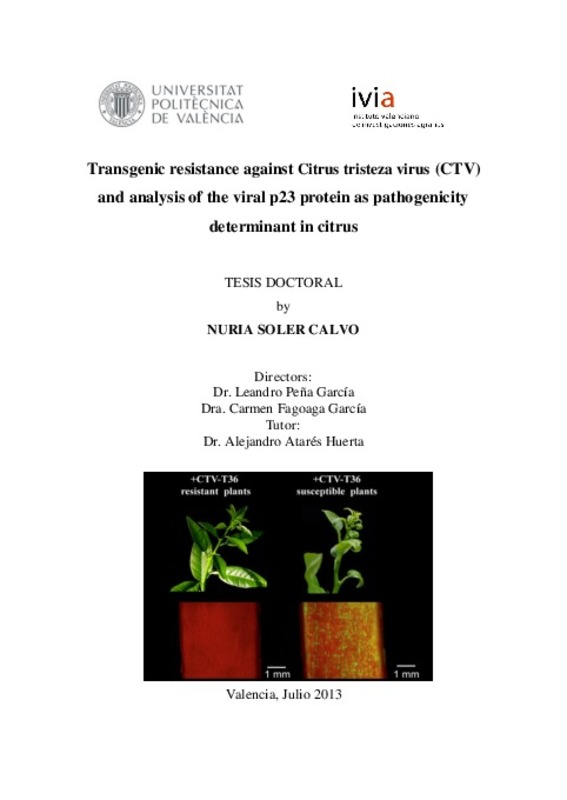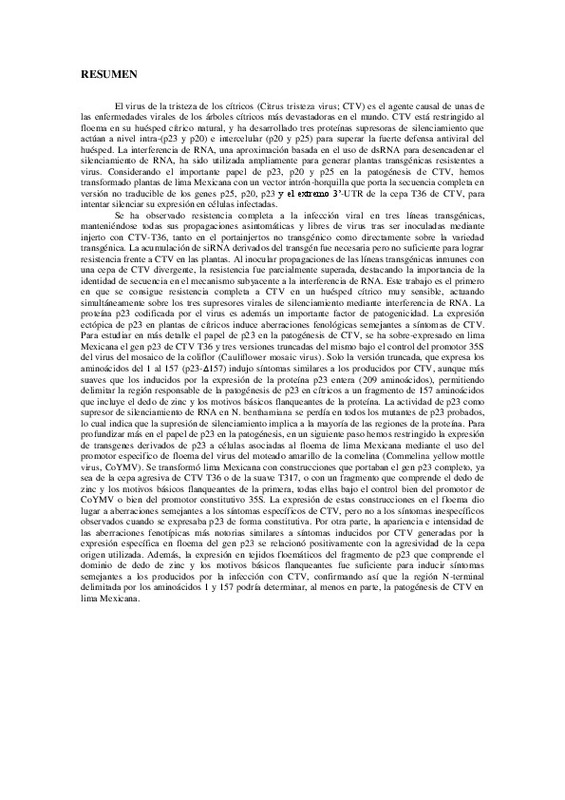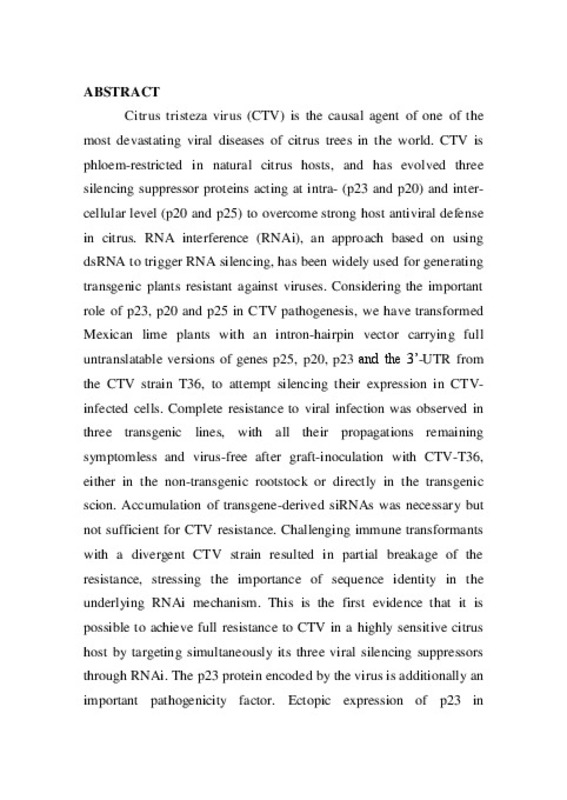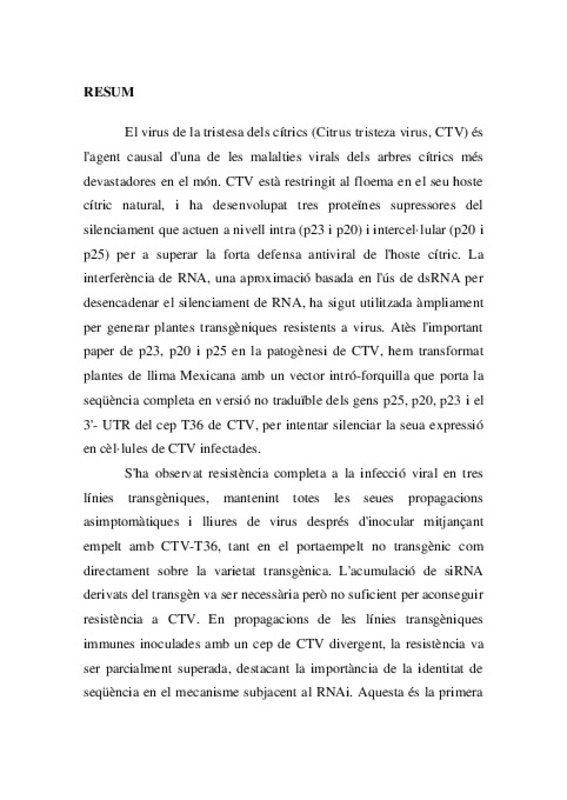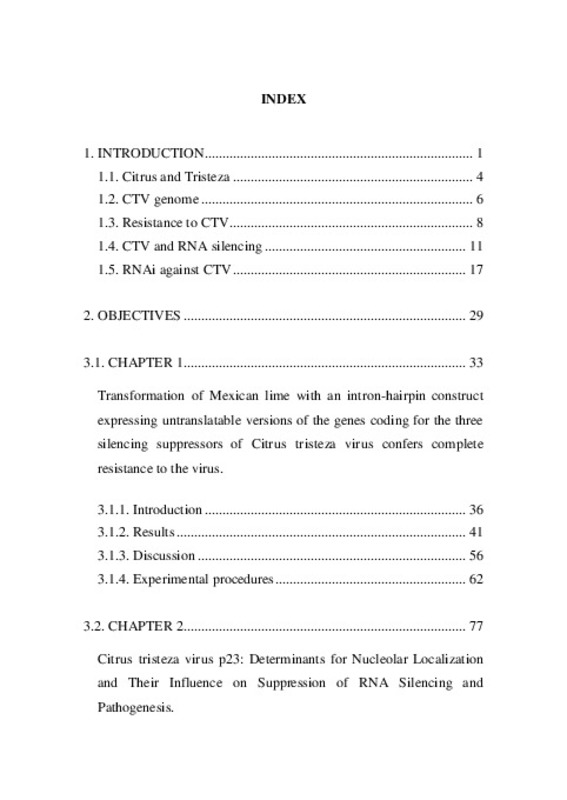- RiuNet repositorio UPV
- :
- Investigación
- :
- Tesis doctorales
- :
- Ver ítem
JavaScript is disabled for your browser. Some features of this site may not work without it.
Buscar en RiuNet
Listar
Mi cuenta
Estadísticas
Ayuda RiuNet
Admin. UPV
Transgenic resistance against Citrus tristeza virus (CTV) and analysis of the viral p23 protein as pathogenicity determinant in citrus
Mostrar el registro sencillo del ítem
Ficheros en el ítem
| dc.contributor.advisor | Fagoaga García, Carmen Concepción
|
es_ES |
| dc.contributor.advisor | PEÑA GARCIA, LEANDRO
|
es_ES |
| dc.contributor.author | Soler Calvo, Nuria
|
es_ES |
| dc.date.accessioned | 2013-09-02T06:36:00Z | |
| dc.date.available | 2013-09-02T06:36:00Z | |
| dc.date.created | 2013-07-15T09:00:14Z | es_ES |
| dc.date.issued | 2013-09-02T06:35:54Z | es_ES |
| dc.identifier.uri | http://hdl.handle.net/10251/31631 | |
| dc.description.abstract | El virus de la tristeza de los cítricos (Citrus tristeza virus; CTV) es el agente causal de unas de las enfermedades virales de los árboles cítricos más devastadoras en el mundo. CTV está restringido al floema en su huésped cítrico natural, y ha desarrollado tres proteínas supresoras de silenciamiento que actúan a nivel intra-(p23 y p20) e intercelular (p20 y p25) para superar la fuerte defensa antiviral del huésped. La interferencia de RNA, una aproximación basada en el uso de dsRNA para desencadenar el silenciamiento de RNA, ha sido utilizada ampliamente para generar plantas transgénicas resistentes a virus. Considerando el importante papel de p23, p20 y p25 en la patogénesis de CTV, hemos transformado plantas de lima Mexicana con un vector intrón-horquilla que porta la secuencia completa en versión no traducible de los genes p25, p20, p23 y el extremo 3¿-UTR de la cepa T36 de CTV, para intentar silenciar su expresión en células infectadas. Se ha observado resistencia completa a la infección viral en tres líneas transgénicas, manteniéndose todas sus propagaciones asintomáticas y libres de virus tras ser inoculadas mediante injerto con CTV-T36, tanto en el portainjertos no transgénico como directamente sobre la variedad transgénica. La acumulación de siRNA derivados del transgén fue necesaria pero no suficiente para lograr resistencia frente a CTV en las plantas. Al inocular propagaciones de las líneas transgénicas inmunes con una cepa de CTV divergente, la resistencia fue parcialmente superada, destacando la importancia de la identidad de secuencia en el mecanismo subyacente a la interferencia de RNA. Este trabajo es el primero en que se consigue resistencia completa a CTV en un huésped cítrico muy sensible, actuando simultáneamente sobre los tres supresores virales de silenciamiento mediante interferencia de RNA. La proteína p23 codificada por el virus es además un importante factor de patogenicidad. La expresión ectópica de p23 en plantas de cítricos induce aberraciones fenológicas semejantes a síntomas de CTV. Para estudiar en más detalle el papel de p23 en la patogénesis de CTV, se ha sobre-expresado en lima Mexicana el gen p23 de CTV T36 y tres versiones truncadas del mismo bajo el control del promotor 35S del virus del mosaico de la coliflor (Cauliflower mosaic virus). Solo la versión truncada, que expresa los aminoácidos del 1 al 157 (p23-¿157) indujo síntomas similares a los producidos por CTV, aunque más suaves que los inducidos por la expresión de la proteína p23 entera (209 aminoácidos), permitiendo delimitar la región responsable de la patogénesis de p23 en cítricos a un fragmento de 157 aminoácidos que incluye el dedo de zinc y los motivos básicos flanqueantes de la proteína. La actividad de p23 como supresor de silenciamiento de RNA en N. benthamiana se perdía en todos los mutantes de p23 probados, lo cual indica que la supresión de silenciamiento implica a la mayoría de las regiones de la proteína. Para profundizar más en el papel de p23 en la patogénesis, en un siguiente paso hemos restringido la expresión de transgenes derivados de p23 a células asociadas al floema de lima Mexicana mediante el uso del promotor especifico de floema del virus del moteado amarillo de la comelina (Commelina yellow mottle virus, CoYMV). Se transformó lima Mexicana con construcciones que portaban el gen p23 completo, ya sea de la cepa agresiva de CTV T36 o de la suave T317, o con un fragmento que comprende el dedo de zinc y los motivos básicos flanqueantes de la primera, todas ellas bajo el control bien del promotor de CoYMV o bien del promotor constitutivo 35S. La expresión de estas construcciones en el floema dio lugar a aberraciones semejantes a los síntomas específicos de CTV, pero no a los síntomas inespecíficos observados cuando se expresaba p23 de forma constitutiva. Por otra parte, la apariencia e intensidad de las aberraciones fenotípicas más notorias similares a síntomas inducidos por CTV generadas por la expresión específica en floema del gen p23 se relacionó positivamente con la agresividad de la cepa origen utilizada. Además, la expresión en tejidos floemáticos del fragmento de p23 que comprende el dominio de dedo de zinc y los motivos básicos flanqueantes fue suficiente para inducir síntomas semejantes a los producidos por la infección con CTV, confirmando así que la región N-terminal delimitada por los aminoácidos 1 y 157 podría determinar, al menos en parte, la patogénesis de CTV en lima Mexicana. | es_ES |
| dc.description.abstract | Citrus tristeza virus (CTV) is the causal agent of one of the most devastating viral diseases of citrus trees in the world. CTV is phloem-restricted in natural citrus hosts, and has evolved three silencing suppressor proteins acting at intra- (p23 and p20) and inter-cellular level (p20 and p25) to overcome strong host antiviral defense in citrus. RNA interference (RNAi), an approach based on using dsRNA to trigger RNA silencing, has been widely used for generating transgenic plants resistant against viruses. Considering the important role of p23, p20 and p25 in CTV pathogenesis, we have transformed Mexican lime plants with an intron-hairpin vector carrying full untranslatable versions of genes p25, p20, p23 and the 3¿-UTR from the CTV strain T36, to attempt silencing their expression in CTV-infected cells. Complete resistance to viral infection was observed in three transgenic lines, with all their propagations remaining symptomless and virus-free after graft-inoculation with CTV-T36, either in the non-transgenic rootstock or directly in the transgenic scion. Accumulation of transgene-derived siRNAs was necessary but not sufficient for CTV resistance. Challenging immune transformants with a divergent CTV strain resulted in partial breakage of the resistance, stressing the importance of sequence identity in the underlying RNAi mechanism. This is the first evidence that it is possible to achieve full resistance to CTV in a highly sensitive citrus host by targeting simultaneously its three viral silencing suppressors through RNAi. The p23 protein encoded by the virus is additionally an important pathogenicity factor. Ectopic expression of p23 in transgenic citrus plants induces developmental aberrations resembling CTV symptoms. To explore in more detail the role of p23 in CTV pathogenesis, the p23 gene from CTV T36 and three truncated versions thereof under the control of the Cauliflower mosaic virus 35S promoter were used to transform Mexican lime. Only the truncated version expressing amino acids 1 to 157 (p23¿158-209) elicited CTV-like symptoms, similar to, albeit milder than, those incited by expressing the whole p23 protein (209 amino acids), thus delimiting the region responsible for p23 pathogenesis in citrus to a 157 amino acid fragment including the Zn finger and flanking basic motifs of the protein. RNA silencing suppressor activity of p23 in N. benthamiana was abolished by all mutants tested, indicating that silencing suppression involves most p23 regions. To better define the role of p23 in CTV pathogenesis, we next restricted the expression of p23-derived transgenes to phloem-associated cells in Mexican lime plants by means of using the phloem-specific promoter from Commelina yellow mottle virus (CoYMV). Constructions carrying the complete gene p23 from either the severe T36 or the mild T317 CTV strains, or a fragment comprising the zinc-finger and flanking basic motifs from the former, either under the control of the CoYMV promoter or the constitutive 35S promoter were used for genetic transformation of Mexican lime. Expression of these constructs in the phloem incited aberrations resembling CTV-specific symptoms, but not the unspecific symptoms observed when p23 was constitutively expressed. Moreover, appearance and intensity of the most notorious CTV-like phenotypic aberrations induced by the phloem-specific expression of the p23 gene were positively related with the aggressiveness of the source CTV strain used. Additionally, expression in phloem-tissues of the p23 fragment comprising the zinc-finger domain and flanking basic motifs was sufficient to induce CTV-like symptoms, corroborating that the N-terminal region (delimited by amino acids 1 and 157) determines, at least in part, CTV pathogenesis in Mexican lime. | en_EN |
| dc.language | Inglés | es_ES |
| dc.publisher | Universitat Politècnica de València | es_ES |
| dc.rights | Reserva de todos los derechos | es_ES |
| dc.source | Riunet | es_ES |
| dc.subject | Transgenic citrus | es_ES |
| dc.subject | RNA interference | es_ES |
| dc.subject | RNA silencing suppressor | es_ES |
| dc.subject | Antiviral defence | es_ES |
| dc.subject | Virus resistance | es_ES |
| dc.subject | Closterovirus | es_ES |
| dc.subject | Intron-hairpin | es_ES |
| dc.subject | Small interfering RNAs | es_ES |
| dc.subject | Phloem-specific expression | es_ES |
| dc.subject | Virus symptoms. | es_ES |
| dc.title | Transgenic resistance against Citrus tristeza virus (CTV) and analysis of the viral p23 protein as pathogenicity determinant in citrus | |
| dc.type | Tesis doctoral | es_ES |
| dc.identifier.doi | 10.4995/Thesis/10251/31631 | es_ES |
| dc.rights.accessRights | Abierto | es_ES |
| dc.contributor.affiliation | Universitat Politècnica de València. Departamento de Biotecnología - Departament de Biotecnologia | es_ES |
| dc.description.bibliographicCitation | Soler Calvo, N. (2013). Transgenic resistance against Citrus tristeza virus (CTV) and analysis of the viral p23 protein as pathogenicity determinant in citrus [Tesis doctoral]. Universitat Politècnica de València. https://doi.org/10.4995/Thesis/10251/31631 | es_ES |
| dc.description.accrualMethod | TESIS | es_ES |
| dc.type.version | info:eu-repo/semantics/acceptedVersion | es_ES |
| dc.relation.tesis | 7659 | es_ES |
Este ítem aparece en la(s) siguiente(s) colección(ones)
-
Tesis doctorales [5389]






